The following article was written by Derrick Savage who served part of his National Service at RAF Greatworth during the summer of 1954 until March 1955, originally posted in two parts as “Early Years” I have brought them together in one article.
A note from Martin.
His pictures illustrate beautifully, life in the post war years of the RAF. Despite his concerns over the quality of his photographic equipment of the time, it demonstrates strongly the oldest of photographic cliches “It’s the photographer that makes the picture, not his camera!”. These are the earliest known pictures of RAF Greatworth.
Reminiscences of RAF Greatworth in the Early Fifties.
Hello everyone.
I am so grateful to Martin for setting up this web site. It was a big surprise to find it. The reason to type into my Internet browser address bar RAF Greatworth came about after I had been delving into some very old photographic negatives. I came across some that I had never turned into positives. Among these negatives were pictures I took with a rather down-market camera of the Greatworth site and the inside of the old transmitter hall. When I digitally converted these into positive form, memories came flooding back. This prompted me to search the Internet for any history of the station. Firstly, I went on to the Google Earth site just to see if the RAF Greatworth site was still there. Needless to say, it wasn’t. I didn’t appreciate until reading the content of Martin’s web site that the transmitter hall is the only feature left, and now has another purpose.
In spite of the relatively low quality of my photographs, it might at most trigger off some memories for those who served there at approximately the same time as myself. At least for the rest of you, together with the following text, it will hopefully give you an impression of what it was like during my stay there so long ago.
I was stationed there for the last few months of my national service from the summer of 1994 to March 1955. Prior to this I had been wrongly posted from Compton Bassett to the remote transmitter receiver site of RAF St Eval in Cornwall. I loved this posting, the location being elevated on high ground with a wonderful view and at the time good weather. A crew of 6 we cooked for ourselves and ran the site like clockwork and enjoyed ourselves. So, it was a bit of a culture shock when it was discovered I was in the wrong place and was to be posted to RAF Greatworth.
Needless to say, my first impression of Greatworth as I entered the gates inspired no enthusiasm. It looked so downbeat. Nissan style buildings everywhere you looked invoked a feeling of foreboding, especially the domestic quarters. Here is where I was to spend the rest of my national service. No exotic overseas posting for me, but it could be worse I thought. On speaking to the lads on that first day, I was assured that it was a ‘cushy posting’ and in spite of its rather dreary appearance there was a friendly atmosphere there, which compensated for this. I had just started a new and unfortunately at that time not very skilled interest in photography. Skill came later, but too late to get better shots of the site, hence the poor standard of the pictures I want to show you, for which I apologise.
Apologies also for repetition of parts of this text of which I had already placed on the guest page. I was told by Martin that so far, I have the earliest recollection of Greatworth. I don’t quite know what that says about me other than I am an old fart. I thought I’d better get that one in first before anybody else does.
As mentioned before, most if not all the buildings had a Nissan hut style of construction, not least the large main transmitting hall. The domestic site buildings were definitely standard wartime Nissan huts of which I lived in throughout the cold winter of 1954-5. It was the cold winter conditions that I associate with Greatworth. The summer of 1954 was good but the weather became progressively colder and colder.
It was my unfortunate luck that the transmitting hall was to be rebuilt whilst not going off air. This meant that the new building was to be constructed around the old large hall. The end wall of this cruciform building where the feeder line switching was achieved, I believe was north facing, was taken down. There was no internal heating of the hall. As you can imagine it was bitterly cold in there particularly at night. The QSY’s became a penance. We devised a method to keep the control cabin at a liveable temperature by bringing a pair of feeder lines through the ceiling from an adjacent SWOB 3 transmitter into the cabin where they terminated into a set of Robertson lamp dummy load. The transmitter was set on a redundant frequency, just in case. A drive signal was applied to power up the side bands and one of the harmonic amplifier stages de-tuned to give a reasonably comfortable warm glow to the lamps. If it was getting too warm in the cabin we would remove the signal drive and the lamps would go off. We didn’t even have to leave the cabin to do that. When needs must and all that.
The extreme cold produced other problems with the mercury vapour rectifier valves in the transmitter power supplies. Sometimes these would not vaporise enough at these low temperatures. Mercury would re-condense on the glass forming a conducting bridge between anode and cathode. This would demolish the 3 phase fuse links with a loud explosive bang when powering up. The fuses would rupture so violently, at times it would demolish the plastic holder they were housed in. Nearly always when this happened, the copper contacts of the 3 phase relays would weld up. It got to a situation that we had to order a lorry load so to speak of replacement fuse holders or the transmitter was left out of use. This we just could not have happen as nearly all transmitters at this time were in use. Signal traffic was very busy during my time there. It was really hairy. One had to work very rapidly at QSY times to beat re-condensation of the mercury problem.
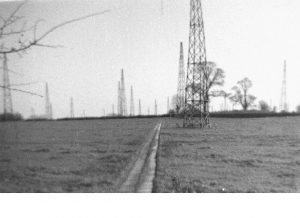 To amuse and lighten our duties in the hall, we had a resident cat. This moggie’s domain was in and around the immediate environs of the transmitter hall. It never ever appeared in the domestic area, where its quality of life could have been much better if it had only realised this fact. It was a young lively cat when it appeared on the site, a good mouser and very playful. When the wooden scaffolding mentioned earlier was erected over the transmitters, this was considered a good reason for the cat to climb up them. It seemed to get some delight in gingerly sniffing the feeder lines, which made it jump when they were live. But it kept doing this until it got fed up with this sort of fun. One day someone alerted us all saying, ‘ The cat has just crawled into the power supply of one of the SWB 11s’ Just before we got to the power supply, a lot of scuffling noises emanated from it followed by a yelp and the power supply tripped out. To our great consternation we thought that it had met its demise. But no, a second or so later it scuffled from under the equipment and literally hot footed up the hall at high speed with its fur smoking. We followed it but failed to find it. After some hours, it appeared slowly walking down the hall and stopped at the control cabin door to be let in. On examination, there was quite a burn on its shoulder and its front paws were quite inflamed, no doubt it was feeling sorry for itself, but careful nurturing restored it back to health within a day or so. It never ventured inside the power supplies again. Being a nocturnal creature, it lazed about the place until night time, then it livened up and did what cats do at that time. It was very affectionate, it knew when it was on to a good thing, after all it was fed on the same diet as we had from the canteen and that never did us any harm, did it!!!
To amuse and lighten our duties in the hall, we had a resident cat. This moggie’s domain was in and around the immediate environs of the transmitter hall. It never ever appeared in the domestic area, where its quality of life could have been much better if it had only realised this fact. It was a young lively cat when it appeared on the site, a good mouser and very playful. When the wooden scaffolding mentioned earlier was erected over the transmitters, this was considered a good reason for the cat to climb up them. It seemed to get some delight in gingerly sniffing the feeder lines, which made it jump when they were live. But it kept doing this until it got fed up with this sort of fun. One day someone alerted us all saying, ‘ The cat has just crawled into the power supply of one of the SWB 11s’ Just before we got to the power supply, a lot of scuffling noises emanated from it followed by a yelp and the power supply tripped out. To our great consternation we thought that it had met its demise. But no, a second or so later it scuffled from under the equipment and literally hot footed up the hall at high speed with its fur smoking. We followed it but failed to find it. After some hours, it appeared slowly walking down the hall and stopped at the control cabin door to be let in. On examination, there was quite a burn on its shoulder and its front paws were quite inflamed, no doubt it was feeling sorry for itself, but careful nurturing restored it back to health within a day or so. It never ventured inside the power supplies again. Being a nocturnal creature, it lazed about the place until night time, then it livened up and did what cats do at that time. It was very affectionate, it knew when it was on to a good thing, after all it was fed on the same diet as we had from the canteen and that never did us any harm, did it!!!
It didn’t happen very often, but when it did, a local storm could be quite spectacular in the hall, particularly at night. It didn’t have to be a storm with lightning absolutely over the aerial field. It could just be a sultry weather condition where atmospheric electrical discharging was taking place down the feeder lines. If flashover occurred between the output coupling coil of the transmitter and output-tuned coil, the transmitter would trip out. We had a few channels of transmission that carried both slow and fast Morse keying. That meant the carrier was commutated on and off. We used to hang a neon bulb on one side of the feeder lines on these channels and they would flash with the signalling. There were a couple of 1509 TXs half way up the hall that these types of channels were used for plus some of the SWB 3s also. During stormy condition at night time, the feeder lines could glow blue and the neon bulbs would stay on for some seconds at a time. No QSYs were allowed during local storm conditions. The following picture is the path from the domestic quarters to the transmitter site, many times trodden during my time there.
The Living Quarters.
That is enough about the transmitting hall. 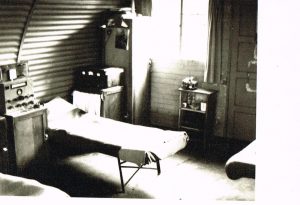 All that is left to describe is the domestic quarters. The domestic quarters were, during the cold winter months, somewhat spartan. I had an end bed by the entrance door to one of these huts. There was one coal stove in the middle of the hut. For me by the door this didn’t exist, as the heat never seemed to reach me there. During the summer being by the door was no problem and there was a window adjacent to my bed space which cheered up that part of the hut. The only other window was half way down the hut on one side. In full daylight, the rest of the hut was quite gloomy. There are pictures below that show a view at the front and rear of the accommodation huts.
All that is left to describe is the domestic quarters. The domestic quarters were, during the cold winter months, somewhat spartan. I had an end bed by the entrance door to one of these huts. There was one coal stove in the middle of the hut. For me by the door this didn’t exist, as the heat never seemed to reach me there. During the summer being by the door was no problem and there was a window adjacent to my bed space which cheered up that part of the hut. The only other window was half way down the hut on one side. In full daylight, the rest of the hut was quite gloomy. There are pictures below that show a view at the front and rear of the accommodation huts.
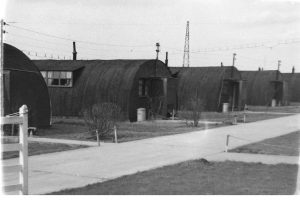
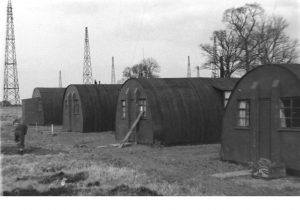
Social life and domestic quarters
Temperature wise these huts would be like an oven in the summer or a fridge in the winter. There were 3 sections to the domestic site. The accommodation huts, the canteen\social rest area and the ablution area. No! There weren’t any ablutions in any of the huts. Can you imagine having to relieve bodily functions on a wintry night when the toilets were some 30 yards away, with no heating in there either.
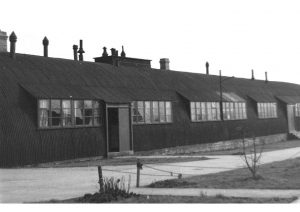
The canteen and NAAFI \ social building, was quite a pleasant building on the inside to spend time in. It was laid out sensibly and the décor was good. It made up for the rather austere rest of the camp. It was always warm in there, a most welcome change from the rest of the place in winter.
In spite of all the trials and tribulations thus described I still enjoyed my time there, even if I haven’t given that impression. This was mainly due to the friendly atmosphere afforded by all the lads who shared these conditions. There was discipline, but it was sensible discipline, there was never any need to harshly apply it. I think it safe to say that all personnel in the technical side of military life were, dare I say it, a cut above the average. Most of the lads were to be involved in technical professions on leaving the RAF as indeed I was too.
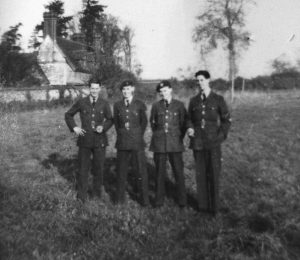
Old Comrades
Strangely I can only remember two names of people that were there at the same time as me, they were Stan Mendham and Derek Rimmer. I believe Stan is the 2nd from the left in the picture above. The rest of their names escape me.
I hope this small presentation has given you an insight as to life at RAF Greatworth in the 19050s
Derrick R. Savage